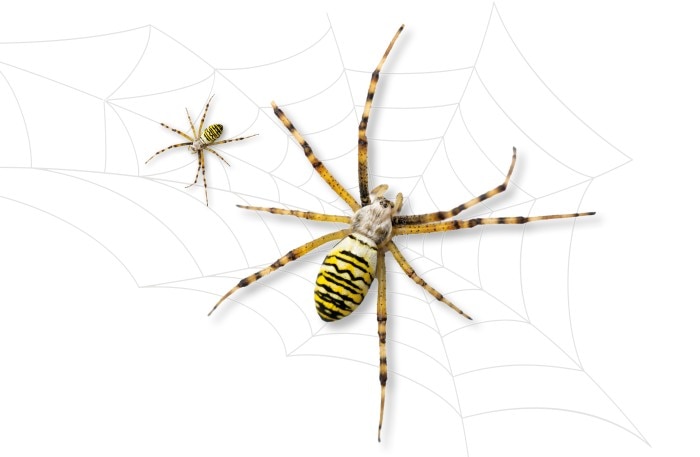MENU
PL | PLN
PL | PLN
-
- Wirówki stołowe
- Wirówka stojąca na podłodze
- Wirówki z chłodzeniem
- Mikrowirówki
- wirówki wielofunkcyjne
- Wirówki wysokoobrotowe
- Ultrawirówki
- Koncentrator
- IVD Products
- High-Speed and Ultracentrifuge Consumables
- Probówki wirówkowe
- Płytki wirówkowe
- Zarządzanie urządzeniem
- Zarządzanie próbkami i informacjami
-
- Pipetowanie manualne & dozowanie
- Pipety mechaniczne
- Pipety elektroniczne
- Pipety wielokanałowe
- Pipety i dozowniki wyporowe
- Automatyczne pipetowanie
- Dozowniki butelkowe
- Pipetory
- Końcówki
- Materiały zużywalne do automatyzacji
- Akcesoria do dozowników i pipet
- Akcesoria do automatyzacji
- Usługi związane z dozownikami i pipetami
Sorry, we couldn't find anything on our website containing your search term.

Fatal Attraction
Odkrywaj Life Science
- Nature
- Off the Bench
- Off the Bench
- Inspirująca nauka
Spiders are not particularly popular. Could this be because not a lot is known about them? Behavioral scientist Jutta Schneider would like to change that. The focus of her research: the sex life of the wasp spider.
Very few people would consider the laboratory of Jutta Schneider a cozy place to be, with its tropical temperatures, high humidity and countless spiderwebs. A horror show for some – everyday work for Schneider. Where others shy away, she takes a closer look: how do the creatures spin their webs? How do they package their prey? How do they mate? While spiders are not very well liked, they are, in fact, everywhere – from the desert to the jungle, coming all the way into our own living rooms, which from time to time leads to unpleasant encounters. “Disgust and fear can be overcome”, knows Schneider.
From childhood, she has been fascinated by the world of animals. Like her idol, Jane Goodall, she initially wanted to live with chimpanzees in the rain forest of Africa. But then life took a different turn. “The offer to work with spiders came from my PhD advisor. Even though I had no idea what I would be getting myself into, I went ahead and accepted”, she remembers. While she did not find spiders repulsive, she did not find them particularly interesting, either. “This changed when I realized how little science knows about these creatures and how fascinating their behavior can be – for example, that of the wasp spider.”
Males as a snack
While elaborating on Argiope bruennichi, Schneider romanticizes: “Even just their black and yellow coloring is charming, as well as the web with its striking zigzag pattern in the center. They are also incredibly good hunters. How they catch grasshoppers and then wrap them up in a matter of seconds – amazing!” Their mating behavior, too, is fascinating. The reason why the males are eaten by the females during the mating act, for example, puzzled even naturalists Charles Darwin (1809–1882) and Jean-Henri Fabre (1823–1915). But now, the secret of the wasp spider has been lifted – not least thanks to research conducted by Jutta Schneider.
Sexual cannibalism is observed in many spider species. The common belief that this kind of food consumption provides an important source of nutrition, however, is mostly incorrect: “For the females, the small males are nothing more than a snack.” Instead, sexual cannibalism has been found to be a part of a more complex strategy. Schneider’s team discovered that the males are capable of mating only twice in their life – by folding out two sperm-filled pedipalps on their heads and interlocking them with one of the female’s two sexual openings.
With each of their two pedipalps, they can fertilize a female once – afterwards, the tip of the pedipalp breaks off and seals the respective opening like a cork. In this way, they ensure that no other male will mate with this female.
Even if the male dies following the first mating act, one half of fatherhood has been secured with this female – even though the males do try very much to escape following the first mating in order to mate with this female a second time. Since the males can use each pedipalp only once, they will have accomplished their life’s purpose after two mating acts. Afterwards, they will die without a fight and thus become easy prey for the inseminated female.
From childhood, she has been fascinated by the world of animals. Like her idol, Jane Goodall, she initially wanted to live with chimpanzees in the rain forest of Africa. But then life took a different turn. “The offer to work with spiders came from my PhD advisor. Even though I had no idea what I would be getting myself into, I went ahead and accepted”, she remembers. While she did not find spiders repulsive, she did not find them particularly interesting, either. “This changed when I realized how little science knows about these creatures and how fascinating their behavior can be – for example, that of the wasp spider.”
Males as a snack
While elaborating on Argiope bruennichi, Schneider romanticizes: “Even just their black and yellow coloring is charming, as well as the web with its striking zigzag pattern in the center. They are also incredibly good hunters. How they catch grasshoppers and then wrap them up in a matter of seconds – amazing!” Their mating behavior, too, is fascinating. The reason why the males are eaten by the females during the mating act, for example, puzzled even naturalists Charles Darwin (1809–1882) and Jean-Henri Fabre (1823–1915). But now, the secret of the wasp spider has been lifted – not least thanks to research conducted by Jutta Schneider.
Sexual cannibalism is observed in many spider species. The common belief that this kind of food consumption provides an important source of nutrition, however, is mostly incorrect: “For the females, the small males are nothing more than a snack.” Instead, sexual cannibalism has been found to be a part of a more complex strategy. Schneider’s team discovered that the males are capable of mating only twice in their life – by folding out two sperm-filled pedipalps on their heads and interlocking them with one of the female’s two sexual openings.
With each of their two pedipalps, they can fertilize a female once – afterwards, the tip of the pedipalp breaks off and seals the respective opening like a cork. In this way, they ensure that no other male will mate with this female.
Even if the male dies following the first mating act, one half of fatherhood has been secured with this female – even though the males do try very much to escape following the first mating in order to mate with this female a second time. Since the males can use each pedipalp only once, they will have accomplished their life’s purpose after two mating acts. Afterwards, they will die without a fight and thus become easy prey for the inseminated female.
Przeczytaj mniej
Monogyny instead of polygyny
Experts know today that this type of sexual cannibalism is not rare among spiders. Schneider: “We are all familiar with the phenomenon of polygyny, meaning that one male can mate with more than one female; however, we had never considered the possibility that there are females who mate with more than one male while these, in turn, can mate only once.” This system of monogyny can also be observed in other species – in anglerfish, for example, as well as other marine organisms. “It is characteristic that within these species, there are more males than females, and that the males are consistently much smaller than their female partners.” A discovery of this kind is fortunate for evolutionary biologists as it is an example of convergence. In instances of convergence, a trait has developed multiple times throughout the course of evolution, in different species, and independent of each other.
But how do Schneider and her team study these creatures? “We observe them, we breed them in the laboratory, and we conduct experiments”, she says. “We want to better understand evolution and, last but not least, our own history.” Moreover, basic research frequently leads to applicable results: spider silk, for example, with its tensile strength and elasticity, is interesting not only to the field of materials science, but it is also employed in medicine.
But even if no direct application is evident, research into the mating behavior of spiders has merit, finds Schneider. “I am of the opinion that we should know as much as possible about our fellow living beings, and spiders happen to be lagging far behind.”
Experts know today that this type of sexual cannibalism is not rare among spiders. Schneider: “We are all familiar with the phenomenon of polygyny, meaning that one male can mate with more than one female; however, we had never considered the possibility that there are females who mate with more than one male while these, in turn, can mate only once.” This system of monogyny can also be observed in other species – in anglerfish, for example, as well as other marine organisms. “It is characteristic that within these species, there are more males than females, and that the males are consistently much smaller than their female partners.” A discovery of this kind is fortunate for evolutionary biologists as it is an example of convergence. In instances of convergence, a trait has developed multiple times throughout the course of evolution, in different species, and independent of each other.
But how do Schneider and her team study these creatures? “We observe them, we breed them in the laboratory, and we conduct experiments”, she says. “We want to better understand evolution and, last but not least, our own history.” Moreover, basic research frequently leads to applicable results: spider silk, for example, with its tensile strength and elasticity, is interesting not only to the field of materials science, but it is also employed in medicine.
But even if no direct application is evident, research into the mating behavior of spiders has merit, finds Schneider. “I am of the opinion that we should know as much as possible about our fellow living beings, and spiders happen to be lagging far behind.”
Przeczytaj mniej
BRIEF PORTRAIT
Jutta Schneider studied biology in Mainz and completed her PhD at the Max Planck Institute for Behavioral Physiology and the LMU Munich. She subsequently conducted research in Israel, Denmark and Australia, and in 2004, she joined the University of Hamburg as a full professor. Jutta Schneider is a renowned global expert within the field of spider research.

